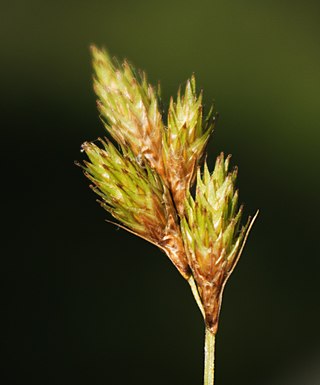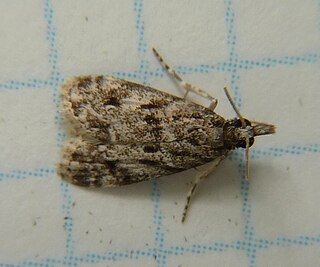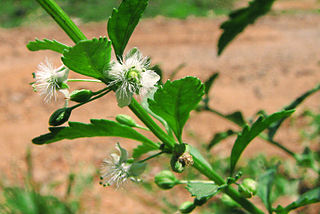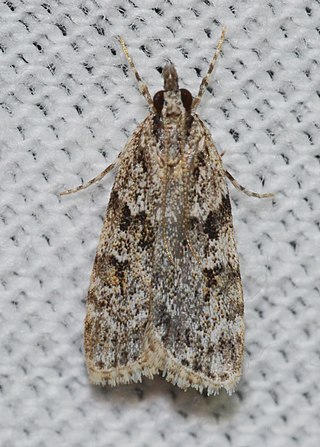
The flathead catfish, also called by several common names including mudcat or shovelhead cat, is a large species of North American freshwater catfish in the family Ictaluridae. It is the only species of the genus Pylodictis. Ranging from the lower Great Lakes region to northern Mexico, it has been widely introduced and is an invasive species in some areas. The closest living relative of the flathead catfish is the much smaller widemouth blindcat, Satan eurystomus, a cavefish.

Scoparia ambigualis is a species of moth of the family Crambidae described by Friedrich Treitschke in 1829. It is found in Europe and Asia Minor and possibly in Guangdong and Shanxi in China.

Carex scoparia is a species of sedge known by the common names broom sedge and pointed broom sedge. It should not be confused with the unrelated grass species known as "broom sedge," Andropogon virginicus.

Scoparia is a grass moth genus of subfamily Scopariinae. Some authors have assigned the synonymous taxon Sineudonia to the snout moth family (Pyralidae), where all grass moths were once also included, but this seems to be in error.

Bassia scoparia is a large annual herb in the family Amaranthaceae native to Eurasia. It has been introduced to many parts of North America, where it is found in grassland, prairie, and desert shrub ecosystems. Its common names include summer cypress, mock-cypress, kochia, belvedere, World's Fair plant, burningbush, Mexican firebrush, and Mexican fireweed, the provenance of the latter three names being the herb's red autumn foliage.
Antonio Olivari was born on 28 September 1980. He is a songwriter and composer from Ħamrun, Malta and has written songs in English and in Maltese.

Scoparia basalis, the many-spotted scoparia moth, is a moth of the family Crambidae. It is found in North America, including Arkansas, British Columbia, Georgia, Maine, Massachusetts, New Jersey, Oklahoma, Tennessee, Virginia and Washington.

Scoparia dulcis is a species of flowering plant in the plantain family. Common names include licorice weed, goatweed, scoparia-weed and sweet-broom in English, tapeiçava, tapixaba, and vassourinha in Portuguese, escobillo in Spanish, and tipychä kuratu in Guarani. It is native to the Neotropics but it can be found throughout the tropical and subtropical world.
Ghedi Air Base is a base of the Italian Air Force in Ghedi, about 15 kilometres from Brescia, northern Italy.
Scoparia apachealis is a moth in the family Crambidae. It was described by Eugene G. Munroe in 1972. It is found in North America, where it has been recorded from Arizona, New Mexico and Utah.
Scoparia benigna is a moth in the family Crambidae. It was described by Edward Meyrick in 1910. It is found on Réunion, Madagascar and Mauritius.

Scoparia biplagialis, the double-striped scoparia moth, is a moth in the family Crambidae. It was described by Francis Walker in 1866. It is found in North America, where it has been recorded from Alabama, Alaska, Alberta, British Columbia, California, Colorado, Florida, Georgia, Illinois, Indiana, Kentucky, Maine, Manitoba, Maryland, Massachusetts, Michigan, Minnesota, Montana, New Brunswick, New Hampshire, New Jersey, New York, North Carolina, North Dakota, Nova Scotia, Ohio, Ontario, Oregon, Pennsylvania, Quebec, Tennessee, Virginia, Washington, West Virginia and Wisconsin.
Scoparia brunnea is a moth in the family Crambidae. It was described by Patrice J.A. Leraut in 1986. It is found in the Chinese provinces of Fujian and Yunnan.
Scoparia congestalis is a moth in the family Crambidae. It was described by Francis Walker in 1859. It is found in Japan, Sri Lanka, Taiwan, Korea, Pakistan, Russia and China.
Scoparia dominicki is a moth in the family Crambidae. It was described by Eugene G. Munroe in 1972. It is found in North America, where it has been recorded from Florida, North Carolina, Oklahoma, South Carolina and West Virginia.
Scoparia huachucalis is a moth in the family Crambidae. It was described by Eugene G. Munroe in 1972. It is found in North America, where it has been recorded from Arizona.
Scoparia nipponalis is a moth in the family Crambidae. It was described by Hiroshi Inoue in 1982. It is found on the Japanese island of Hokkaido, the Chinese provinces of Henan and Shanxi and in Russia.
Scoparia subgracilis is a moth in the family Crambidae. It was described by Sasaki in 1998. It is found in Taiwan and China.
Scoparia tohokuensis is a moth in the family Crambidae. It was described by Hiroshi Inoue in 1982. It is found in China, Japan and Russia.

Portrait of Fra Teodoro of Urbino as Saint Dominic is an oil painting on canvas by the Italian Renaissance master Giovanni Bellini, dating to 1515. His final portrait, it is in the collection of the Victoria and Albert Museum in London, from which it is on long-term loan to the National Gallery in the same city. It depicts an old prelate with the attributes of Saint Dominic, including an austere black cap and a white lily.








